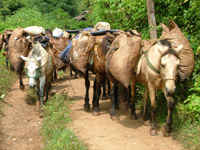
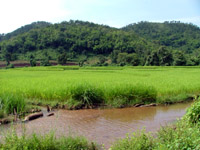
On Saturday I went on a trek into the hills near to Hsipaw. I'd had a bad night's sleep, only catching a few hours. The previous night the town had become wonderfully quiet around ten o'clock, once everyone's generators had run out of fuel, but on Friday night the government electricity was on for a change, and I could hear bad kareoke being sung in celebration way past midnight. Around two o'clock a storm that had been flashing away in the distance for hours moved in, and the rain on the tin roof of my bathroom made me curse my decision to go with an en suite. I'd set my alarm for five thirty, planning to pay a visit to the morning market, but I decided against that as it was still raining. I felt tired and groggy at breakfast, and hoped to persuade Mr Bean to do a shorter walk, but to no avail - he was determined that I do the hike. I'm not really a hike sort of person; I'm more of a stroll in the park girl, really. I like to take all day over a two-hour walk, looking out for photo opportunities along the way, and enjoying the sights, sounds and smells of nature. I'm the same when I'm diving - I like to have a cruisey dive, taking it slowly and looking at all the little stuff.

We began by walking along the road out of town, then walked alongside the graveyard into the country, past paddy fields and small villages. The "four hours up" were broken by a stop at a tea shop in a small village along the way, where we each had a coffee washed down with lashings of Chinese tea, and Mr Bean indulged in a spot of rice liquor. I tried some, but I made the mistake of sniffing it first, and nearly gagged on the vapours. It smelt as bad as lao-lao, though the taste was not quite as bad - more rubbing alcohol than turps. We continued up, with me calling the occasional halt, gasping to catch my breath. I was grateful that the weather was overcast; I'd have dawdled too much taking photographs if the sun had been out, and at least the clouds was cooler for walking. We passed several groups of horses coming towards us, with large canvass sacks strapped to their sides. Mr Bean explained that they were carrying tea leaves, a big crop in the area. Corn is also grown in places, along with mountain rice (glutinous or sticky rice), beans, and other vegetables. Mostly these are just to feed the families who grow them; when the supplies are exhausted they must venture into town for more.
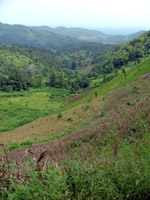
We walked for a long time along the side of a hill, climbing steadily as we went, looking down into a picturesque valley where a single house stood. Mr Bean told me that the farmers do not buy the land; if they clear it, then they can have it. We walked on, reaching an area off different terrain, where trees were absent, but strange rocks jutted up out of the stony ground instead, and numerous flowers resembling bluebells gave the land a purply tinge. I was almost out of steam, but fortunately there was only a little more "up" to go before we reached the Palaung village where Mr Bean's friend lived. He had explained to me that there was no restaurant in the village, so we would eat at his friend's house, and suggested that 1,000 kyat would be a reasonable amount to give for the meal.
I was welcomed into the stilted, wooden house and climbed the stairs to the living area. A small fire burned in the middle of the room, giving off only a little smoke. A fat, contented cat licked himself in front of the fire, whilst a tiny, frail-looking kitten stood by. Against the light, his back legs became transparent, and fleas were visible squirming around in his thin, ginger fur. Two small boys with snotty noses played a noisy game with marbles, and Mr Bean and his friend caught up on the gossip whilst I sipped my Chinese tea, replacing the fluids lost on the trek. Before long dinner was served on a small, round table, and I was kindly given a low stool to sit on. Along with a big bowl of rice I had bean leaf soup, and a kind of crunchy nut salad, with peanuts and sesame seeds, with plenty of rice. The other dishes contained meat or fish - two of them had bees in - yes, bees, that's not a typo! There was bee soup and crunchy bee salad. Mr Bean urged me to try some, but I declined. In case you are wondering, as I did, they do remove the stings before cooking them.
After the meal we took a stroll around the village, where about a hundred homes are gathered. We stuck our heads inside the small school, where a maths lesson and an English lesson were in progress, and then visited the monastery where the young novices were learning Pali script. I'm pleased to say that I didn't feel at all as if I was intruding. My presence did not cause too much of a stir, and the little kids seemed happy to have a foreigner to wave at, and practise their English greetings, "hello", "bye-bye" and "thank you" being used interchangeably. Two little ones followed me for ages, shouting "bye-bye" and waving - they were absolutely adorable.
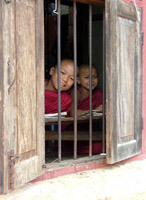
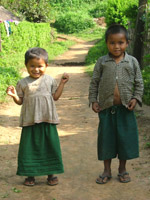
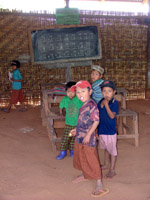
The downward journey was a lot easier, and we took a shortcut that would have been too steep going up. Even so we were walking for another three hours, and would have got back after dark, had it not been for a bus driver giving us a lift once we reached the road. I asked how far we had walked, and was told about twenty kilometres; not bad going for a lazy girl. It was a long old day, but a thoroughly enjoyable one, in the company of the good-natured Mr Bean. I remembered to do some stretches on my return, and took a welcomed hot shower, so I hardly ached at all the following morning.
---------
I awoke to the realization that I did want to see the ancient cities near Mandalay; my next thought was that I really should have returned to Mandalay that morning. I had planned to stop at a town not far from Hsipaw, to go trekking with a bright young lad that I'd spoken to on the train, who had excellent English. I wondered, though, whether I had enough time to do both. The buses to Mandalay leave Hsipaw at six in the morning, so I figured I was stuck with plan A, like it or not. I was lamenting this fact to Mr Bean over breakfast, who told me that I should be able to catch a pickup on its way through from Lashio, so I packed up and stood outside the guesthouse with Mr Bean. We were there for an hour or so, but the only pickups that came through were fully laden - and then some. One had belongings piled several feet high on top of the truck, making it look as if it would topple over any second. Eventually one stopped, and I squeezed inside, handing my 2,000 kyat to the driver.
It was a different design than I am used to: instead of two rows of seats, parallel to the road, this one had three bench seats across the vehicle. It seemed a strange use of space to me, as they could have fitted more people in the other way, but they must have had their reasons, as each truck that had passed had been of the same design. The body of the truck was full of boxes, which came up to the seats. This meant that our feet were level with our bums, our knees against our chests. It wasn't too arduous a journey - I've had worse - you just have to go through the uncomfortable stage and the painful stage, to get to the numb stage - then you're okay. It was nigh on impossible to get a view - not without doing a passable impression of a hunchback, at least - so I listened to Pink Floyd and closed my eyes.
The vehicle started twisting and turning along the road, and I realised that we were approaching Gokteik Gorge, and quickly crunched a motion sickness tablet. The exhaust snapped, crackled and popped as we wound our way down the switchbacks to the bottom of the gorge, and even more so when we started to climb up the other side. I got my camera at the ready, hoping for a glimpse of the viaduct, and bent my neck uncomfortably trying to follow the scenery as it waltzed this way and that. There was one point when I had a clear shot of it, but I wasn't quick enough and it whipped out of sight for good. It obviously wasn't meant to be.
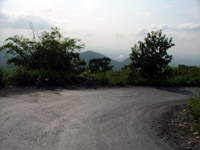
On the outskirts of Mandalay we stopped. A number of passengers got off, and my pack was handed down to me from the roof of the vehicle by the driver's assistant - who had the most prominent jaw bones I've ever seen; as he chewed the betel nut, it looked like he had a hamster in each cheek trying to tunnel its way out. I apprehensively asked how I would get into the city. The driver asked which hotel I would be staying at then motioned me back inside the vehicle, and we drove until we found a regular town pickup that would take me the rest of the way. This second vehicle was manned at the back with three young boys, who were making a lot of noise. At the time I got on it was around half full (by Asian standard; there were only a couple of seats left), and I realised that we were chasing buses as they approached the city. The boys were shouting to persuade the passengers off the bus and onto the pickup, before it got to the bus station. Once we were all squeezed up along the bench seats, and the little wooden stools were taken, and several men were sat upon the roof, and several more hung from the back of the vehicle, we stopped our pursuit, and moved more purposefully towards the town.
I chose on this occasion to lodge at Nylon Hotel. There was nothing wrong with the Royal, where I'd stayed the last time, but I had no urge to return to the place where I'd been sick; I'd seen enough of the back of the toilet door there to last me. At Nylon I chose an en suite room with fan for $4, turning down an air con room with fridge and TV for just a dollar more - I don't like air con, and usually turn it off, so a room with air con and no fan is no good for me. I think the manager was concerned for my sanity, and tried to convince me to go with the air con. There was no towel in the room, so I asked at reception to see if I could get one (I have a travel towel, but I am loath to use it). The guy spent some time looking, and then asked me to wait in my room. He knocked on the door a short time later to deliver soap, toilet paper, and a towel that I am convinced had just been bought - that's what I call service!
I decided to settle for seeing three out of four of the old capitals. (Mingun has to be seen on a separate day, and if I did that on Tuesday, I'd be leaving Mandalay on a Wednesday. I'm planning to catch the private express boat to Bagan, but only the government one runs on a Wednesday.) I arranged for a taxi via the hotel to take me to see Inwa, Sagaing and Amarapura. The cost was ten dollars, plus entrance fees and a few other sundries. During a five hundred year period, before Mandalay became the capital of Myanmar in 1860, each of the four cities had been the country's capital a number of times. Once a king came to the throne, he would choose a new capital and the wooden palace and other royal buildings would be dismantled and moved to the new seat of power. When that king was succeeded, the following ruler would do the same, and everyone would up sticks and move again.
That decided I went to use the Internet, discovering that the server at the place I'd used the last time was down. They directed me to another place, where I was able to access hotmail, as well as gmail. The drawbacks were the price, $3 an hour, and the fact that it was very slow, but I was at least able to update the website and let my folks know I'm still alive.
---------
After breakfast (real coffee - the first I've had here - eggs, toast, and a slice of papaya) I went downstairs and met my driver for the day plus my guide. This threw me a little as I hadn't realised I was getting a guide too, and wondered at first whether they'd be an extra charge at the end of the day. I needn't have worried, though, and he was a nice guy. We went first to see some stone cutters at work, shaping marble into Buddha images, followed by a woodcarving shop, where the owner had been collecting marionettes for twenty five years, and was disappointed that I didn't want to buy any. We had some time to kill, so stopped at a tea shop. There the guide told me that he and the driver were hungover, as they'd been out drinking the previous night. The driver tucked into a hearty breakfast, while I supped my tea and watched as a horse hitched to a cart tried in vain to scratch an itch on his back.
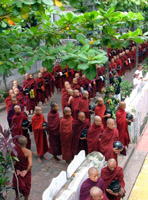 Once we'd finished we drove to a big temple nearby (sorry, forgot the name) that houses 1,500 monks, novices and nuns. Whereas monks usually go around with their alms bowls collecting food from those wishing to make merit (an activity that seems to take up half the day here), they do things slightly differently at this place. Large companies and wealthy benefactors donate vast quantities of food, and each morning the monks line up to receive their share of it, in what has become a well-attended tourist event. The long lines of sombre, red-robed monks, and young, shaven-headed nuns in pale pink garments was impressive, but I did feel sorry for them having to put up with cameras clicking in their faces each morning. The whole thing had a feel of feeding time in the zoo. I did my share of clicking, of course - it was too good an opportunity to miss. Afterwards my guide told me how he does not really approve of the way things are done here. He said some of the big rice companies put up signs boasting of their contribution. I imagined monks sponsored like footballers, with logos on their robes.
Once we'd finished we drove to a big temple nearby (sorry, forgot the name) that houses 1,500 monks, novices and nuns. Whereas monks usually go around with their alms bowls collecting food from those wishing to make merit (an activity that seems to take up half the day here), they do things slightly differently at this place. Large companies and wealthy benefactors donate vast quantities of food, and each morning the monks line up to receive their share of it, in what has become a well-attended tourist event. The long lines of sombre, red-robed monks, and young, shaven-headed nuns in pale pink garments was impressive, but I did feel sorry for them having to put up with cameras clicking in their faces each morning. The whole thing had a feel of feeding time in the zoo. I did my share of clicking, of course - it was too good an opportunity to miss. Afterwards my guide told me how he does not really approve of the way things are done here. He said some of the big rice companies put up signs boasting of their contribution. I imagined monks sponsored like footballers, with logos on their robes.
We popped into a silk weaving factory, and watched the skilled workers for a while - it did make me appreciate the cloth more, having seen the work that went into it...not enough to buy any, mind. Then it was on to the ancient city of Inwa, which was separated from the mainland by a canal, making it into an island. Inwa - known as Ava by the British - was the capital three times. The guide and I caught a small ferry to the island, getting a good view of the British-built Ava bridge on the way. I'd read that photography was strictly forbidden, so took some shots in revenge for missing out on the Gokteik Viaduct. At Inwa, it is customary to hire a horse and cart to tour the island, at a cost of 2,500 kyat. I rejected the first horse, on account of his being too skinny. It's always a tough call, but I'd like to think that if tourists refuse to accept animals that are in bad shape, it will encourage the owners to treat them better; of course the other way of looking at it is that by not giving them business, the owners will be unable to feed their animals.
The second horse was a healthy-looking beast, with a glossy coat, and the driver was a decent chap. He didn't have much English, but was keen to share his knowledge with my guide, who made notes his for future reference. He said that we could go and see monks' bowls being made if we liked, for an extra 500 kyat as it was quite a detour to get there. I'd seen bowls being made in Thailand, and was curious to know whether they used the same methods here, so agreed to go along. The Thai bowls are made by first welding several pieces together, into an octagonal shape, and then beating them until they are smooth and round. Here they do it the hard way, by taking a flat disk of metal, and beating that into a bowl, a process that takes two hours. This is just the beginning, as the bowls are then heated over a fire, rubbed with ash, greased, and rubbed smooth. The last two steps are repeated again and again, until the bowl becomes glossy and black. The metal comes from large oil drums, each drum making 24 bowls. It was fascinating to watch, and to see the stacks of bowls, wrapped and ready for shipping.
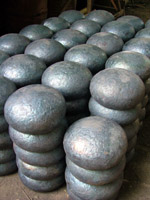
We visited the teak temple, Bagaya Kyaung, and a tilting watchtower, which gave good views of the gold-topped stupas of Mandalay. After a couple of hours we had completed out circuit of the pretty island, and returned to the jetty to catch the small boat back to the mainland. The driver was sound asleep in the back of the taxi (which was like a miniature pick-up), and awoke in a bad mood. I thought he'd been sleeping off his hangover, but he'd been boozing in our absence, so was now a tad drunk. I knew this because the woman in the restaurant told the guide, and he told me. The two were friends, but he was not impressed at the driver's behaviour. He had another big meal to soak up the alcohol, mixing a fish dish into the bowl of rice with his fingers, and stuffing great handfuls into his mouth.
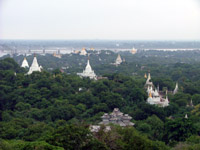
Sagaing (twice capital) was the next city on the list, but we stopped first at Thabyedan Fort, which was built in an effort to repel the British, but failed miserably. We drove across Ava Bridge, and I took more photographs, just for the hell of it. The driver dropped us at the foot of the hill, and we climbed up for more great views. I preferred this hill to Mandalay Hill, which had seemed something of an anticlimax once I'd reached the top. A young monk approached me to practise his English, explaining that he was normally too shy to speak to foreigners. We hung around for a while then descended, pleased to find that the driver was not too much the worse for wear.
The last ancient city we visited was Amarapura, which two kings chose for their capital. The main point of interest - for me, at least - was U Bein's Bridge, a fantastic wooden structure 1.2 kilometres long, which offered a whole host of photographic opportunities: old, leafless trees sprouted out from the flooded fields; men and women stood in the water fishing, some submerged up to their necks; young novices leaned over from the bridge, watching fish feeding from the surface of the water; ducks headed home, herded by men in rowboats. And as the sun began to sink in the sky, the light just got better. It was just about the first time I'd seen the sun all day, and I was grateful for its timely appearance. An invisible bank of cloud claimed it before it reached the horizon, though, so I missed out on capturing silhouettes against the setting sun, which was a shame. My guide told me that summer time is the best time, as the skies are clear and the fields - which were underwater at the time - are full of colourful flowers. I shall have to return one day.
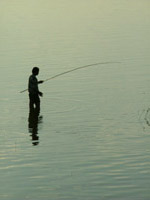
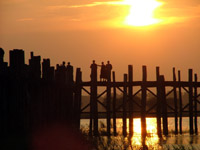
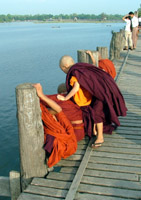
The driver was not far from legless when we got back, searching frantically for the keys, which he'd placed on the passenger seat. But he got us back to the hotel in one piece, so it remained a day to remember for all the right reasons. It's an early start for me tomorrow - the boat leaves at six o'clock, and I've a taxi booked for five - horribly early. Next stop the ancient city of Bagan.
 Visit SerenityPhotography.co.uk, where you can buy beautiful pictures from around the world...all taken by yours truly! |